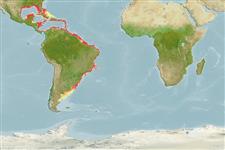Environment: milieu / climate zone / depth range / distribution range
Ecology
Marine; freshwater; brackish; demersal; catadromous (Ref. 46888); depth range 10 - ? m (Ref. 3791). Subtropical; 32°N - 51°S
Western Atlantic: Bermuda, Florida (USA), Bahamas, and throughout the Caribbean Sea to Argentina.
Length at first maturity / Size / Weight / Age
Maturity: Lm 35.0, range 40 - ? cm
Max length : 80.0 cm TL male/unsexed; (Ref. 5217); 69.0 cm TL (female); common length : 40.0 cm TL male/unsexed; (Ref. 5217); max. published weight: 9.0 kg (Ref. 5217)
Inhabit coastal marine waters and brackish estuaries (Ref. 3791); also found in hyper-saline lagoons and may enter freshwater (Ref. 5217). Never far from the sea (Ref. 3791). Form sizeable schools (Ref. 3791). Appear to undergo trophic migrations along the coasts (Ref. 35237). Feed on organic detritus and filamentous algae (Ref. 9626). Oviparous, eggs are pelagic and non-adhesive (Ref. 205). Spawn several million eggs (Ref. 35237) at sea (Ref. 3791). Also caught with beach nets (Ref. 5217). Marketed fresh and salted (Ref. 5217). The roe is marketed salt-pickled and dried and considered a delicacy (Ref. 5217).
Life cycle and mating behavior
Maturities | Reproduction | Spawnings | Egg(s) | Fecundities | Larvae
Robins, C.R. and G.C. Ray, 1986. A field guide to Atlantic coast fishes of North America. Houghton Mifflin Company, Boston, U.S.A. 354 p. (Ref. 7251)
IUCN Red List Status (Ref. 130435)
Threat to humans
Harmless
Human uses
Fisheries: commercial; aquaculture: commercial
Tools
Special reports
Download XML
Internet sources
Estimates based on models
Preferred temperature (Ref.
123201): 22.5 - 27.7, mean 25.5 °C (based on 280 cells).
Phylogenetic diversity index (Ref.
82804): PD
50 = 0.5000 [Uniqueness, from 0.5 = low to 2.0 = high].
Bayesian length-weight: a=0.01047 (0.00905 - 0.01211), b=2.95 (2.92 - 2.98), in cm total length, based on LWR estimates for this species (Ref.
93245).
Trophic level (Ref.
69278): 2.0 ±0.00 se; based on food items.
Resilience (Ref.
120179): Medium, minimum population doubling time 1.4 - 4.4 years (K=0.11-0.24; assuming tm=2-3).
Prior r = 0.33, 95% CL = 0.22 - 0.50, Based on 7 data-limited stock assessments.
Fishing Vulnerability (Ref.
59153): Moderate vulnerability (37 of 100).
Climate Vulnerability (Ref.
125649): High vulnerability (57 of 100).
Nutrients (Ref.
124155): Calcium = 152 [57, 453] mg/100g; Iron = 2.51 [0.46, 11.24] mg/100g; Protein = 19.8 [18.3, 21.2] %; Omega3 = 0.464 [0.221, 1.025] g/100g; Selenium = 60.8 [21.7, 208.2] μg/100g; VitaminA = 6.03 [1.72, 21.87] μg/100g; Zinc = 1.73 [0.83, 4.23] mg/100g (wet weight); based on
nutrient studies.
